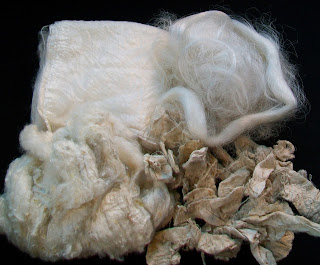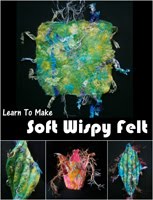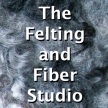We’ve had a lot of new visitors to the
Studio site recently, and lots of
new members on the
forum, so I thought it might be time to do a
reminder about everything we have to offer here on the Studio site.
Before we started the blog just over a year ago, the four of us spent
about 6 weeks working on the site, filling it with as much info as we
could. We wanted to build the site into a valuable ‘One-Stop’ resource
for anyone interested in felting and fibre. The
‘About Us’ page tells you a little bit about why we started the
Studio site, and there are sub pages for each of us with some info about
ourselves and our interests.
In the
Felting section there’s a short introduction about the many
different kinds of felting. The main pages for Machine, Needle, Nuno and
Wet felting all have more in-depth information, and each has a gallery
page with many different examples of that particular type of felting.
Mixed media simply means artwork that is made with more than one medium,
but for the purpose of the site we use it to mean artwork made mainly
with felt or fabric combined with other materials. This section features
pages about Beads and Beading, Hand Stitching, Machine Stitching and
Surface Design. Each page’s gallery features many examples of artwork.
The
Fibers section is packed full of information about wool and other
animal fibres. The main Fibers page explains some of the different terms
that are used to describe wool in its various stages of processing. The
Wool and Other Animal Fibers page has a lot of information about wool,
animal fibres from animals such as Alpaca, Angora goat, Llama and Camel.
There is also an explanation of the Micron and Bradford Count systems
of measuring a fibre’s fineness or coarseness; and a PDF guide to the
most common sheep breeds and their Bradford and Micron numbers. The
gallery page features photos of different animal fibres. Preparing
Fibers has a guide to processing your own wool, from washing a raw
fleece to carding it into fluffy batts ready for felting or spinning.
There is a photo set and detailed description.
The
Other Fibers section has lots of information about the non animal
fibres we commonly use in felting, such as silk and organza fabrics;
fibre prepared into tops like bamboo, banana, viscose, and the more
unusual fibres like crimped nylon, plastic and Angelina fibres.
The Silk page shows the many different silk products available, for
example, silk carrier rods, silk hankies and silk throwster’s waste and
the gallery page features many uses of these. The Man-made fibers page
and its gallery have examples of fibres and their uses including
commercial art yarns and some nuno felt examples with synthetic
fabrics. The Plant Based Fibers page has many examples of these gorgeous
luxurious fibres and felted pieces using them.
The
Tutorials section is another area with a wealth of information.
There are free Dyeing, Felting, Fiber preparation and Mixed media
tutorials all written by one of us, including a video on how to make
your own roving using a diz, PDFs on Degumming silk and dyeing it;
Stitching on felt, making mixed media wall art, using a sander for
wet-felting, a beginners guide to using a drop spindle and dyeing with
food colouring.
And if you can’t find what you want there, there are also links to
outside sites in the
Links/Resources section, including
rosiepink’s free
felting tutorials and their fantastic
e-book showing how to make
amazing felt artwork and Ruth’s book
The Complete Photo Guide To Felting.
We've been working on upgrading the site over the last week or so, and have added new photos to the different pages and to the galleries. We also added a new
Fabrics page. This is in the 'Other Fibers' section and also has its own gallery.
So, make yourself comfortable and come over and have a look around
the site.
We’re always happy to read comments and listen to suggestions for
adding more to the site, or to requests for articles or tutorials. Maybe
you are a fibre artist with an interesting skill that would make a
great feature or you’d like us to link to a tutorial, if you have
anything felt or fibre related you want to tell us about, we’d love to
hear about it :)



































